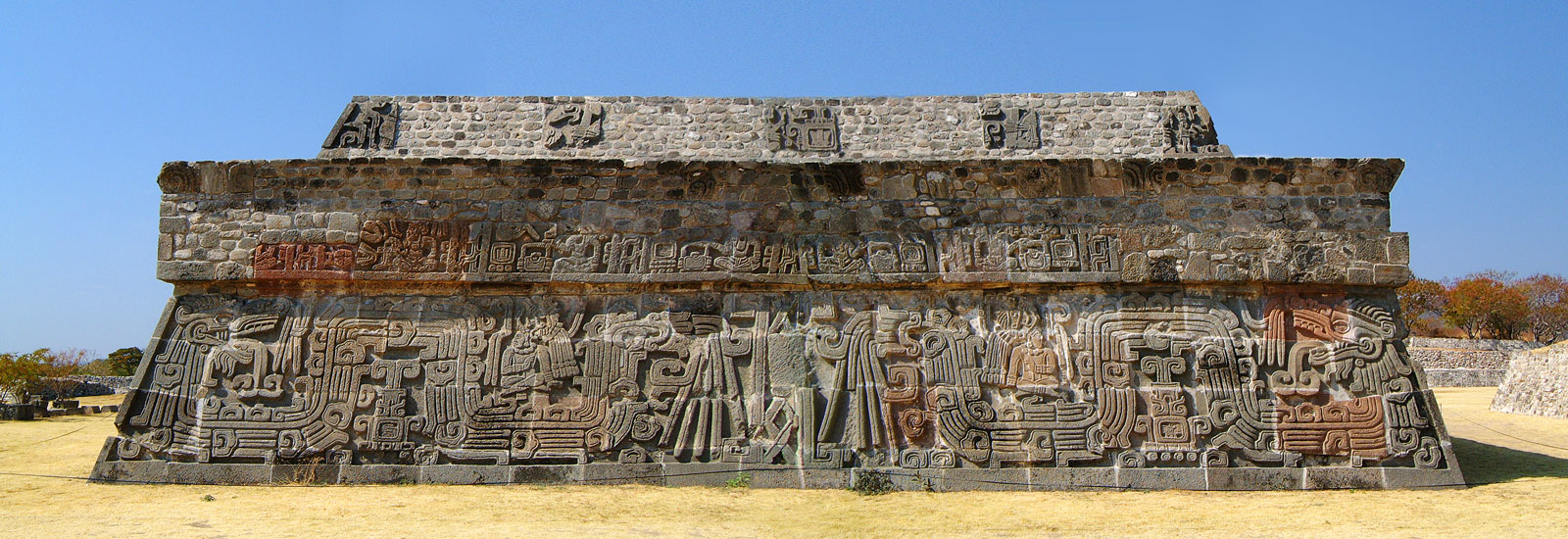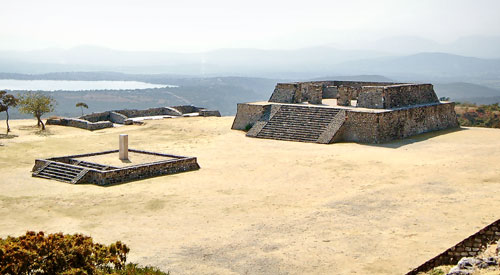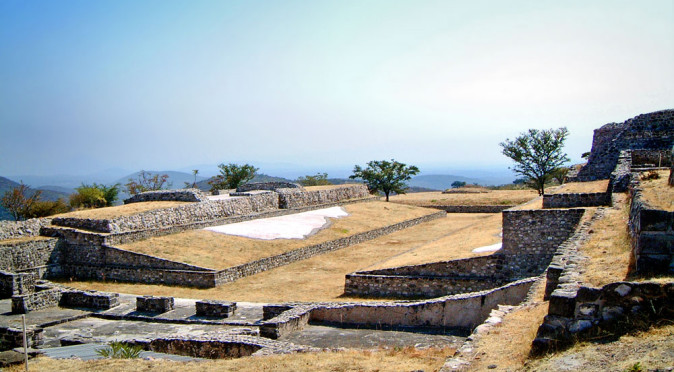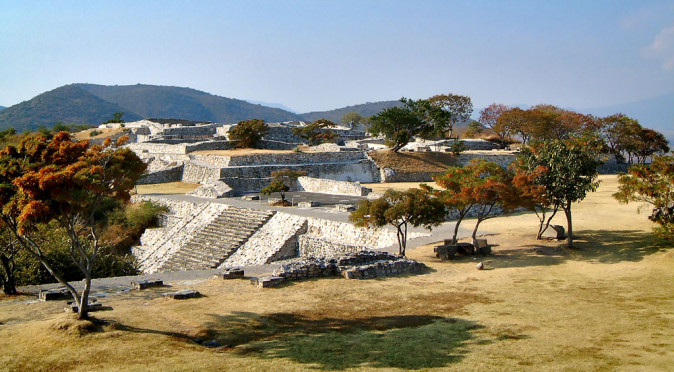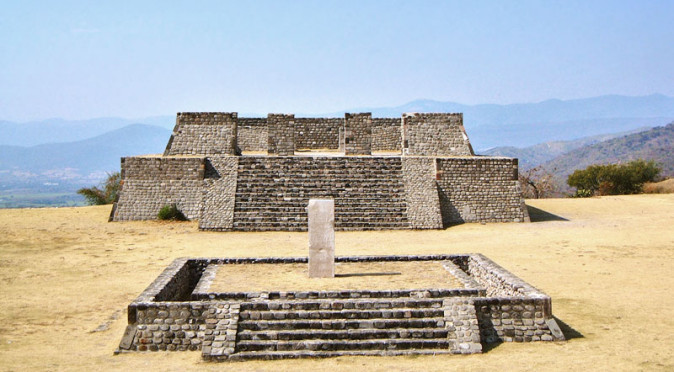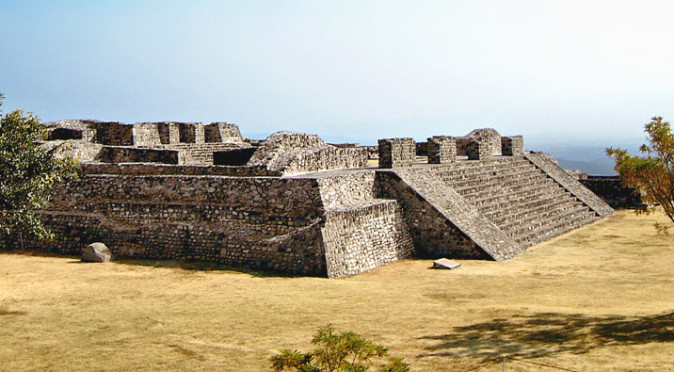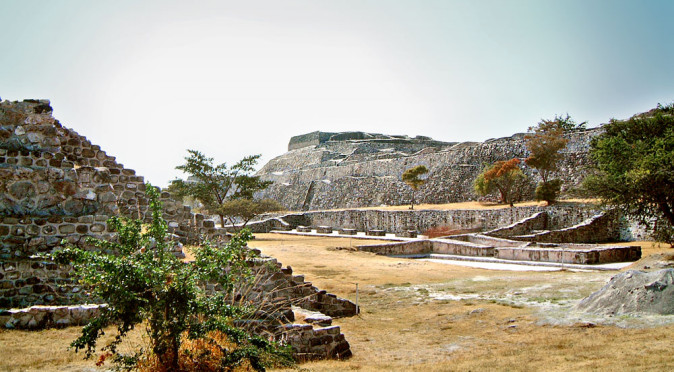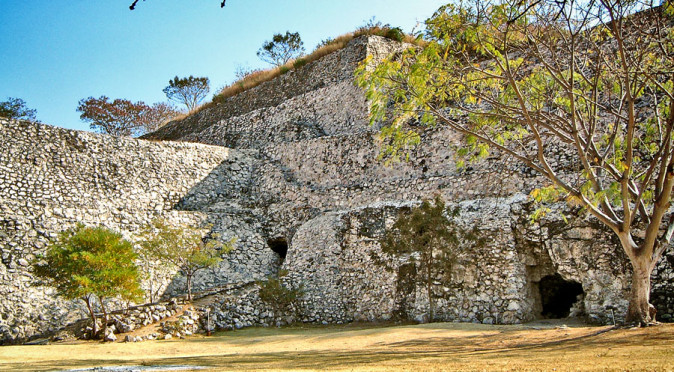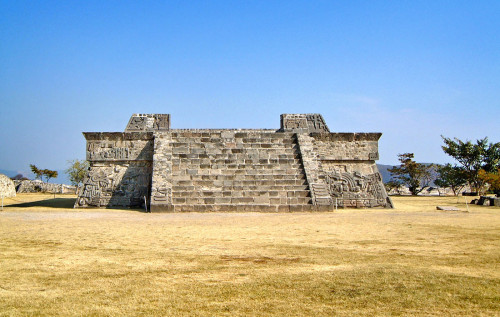
W0095: Pyramid of the Plumed SerpentThe iconic Pyramid of the Plumed Serpents at Xochicalco is potentially one of the most important buildings uncovered in Mesoamerica. Known colloquially as the Pirámide de las Serpientes Emplumada, it measures an impressive 21m by 19.6m and is named after the carvings of eight huge serpents with plumes of feathers sprouting from their heads and tails that wrap around its lower walls. These snakes are thought to represent the god Quetzalcoatl, whose name means “Feathered Serpent”, although others believe they represent the snake-mountain-monster, whose winding body echoes the undulating hills of the Mesoamerican terrain, whilst other research suggests that the snakes are designed to associate those pictured entwined within the serpents’ bodies as rulers Xochicalco. Meanwhile, Mayan symbolism uses the serpent to describe celestial matters relating either to the ecliptic path or the milky way – and with the clear Mayan influences found within the artwork of the Pyramid of the Plumed Serpents, it would be hard not to include this as a possible definition.
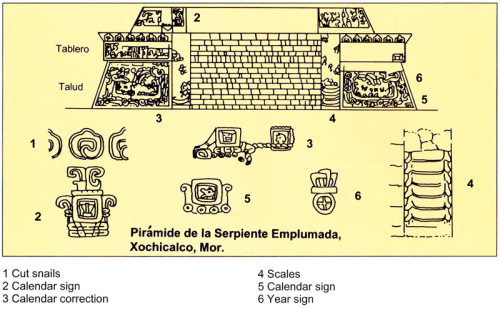
W0061P2D: Diagram of Serpent Temple Detail Whilst the serpents dominate the carved walls, their role within the text appears to be minor and it is the hundreds of smaller carvings that tell the story that the Pyramid of the Plumed Serpents was designed to record. The most popular theory on the meaning of the carvings is centred around the decipherment of one glyph on the lower wall to the left of the stairway. Here, resting within the coil of one of the serpents, is a glyph representing the date 5-Calli, or “five-house”, which is tied by rope to a date glyph for 11-Ozomatli, or “eleven-monkey”, with hands emanating from the sides of the glyph that appear to be pulling on the rope. It is believed that this scene describes the “pulling” forth of the date eleven-monkey in a recalibration of the sacred calender. The sacred 260-day calender and the 365-day calendar were aligned with celestial observations that recurred over both short periods (months and years) and long periods (centuries and possibly millennia). The calendars were designed this way to allow for the accurate recording of terrestrial events using the celestial events witnessed at the time, which then allowed for these seemingly unpredictable terrestrial events to be predicted using the cyclical, and very predictable, celestial events. Therefore, the predominate theory is that a celestial event was either occurring out of synchronicity, or that hadn’t previously been accounted for, and that a meeting of the “Lords of Time” from across of Mesoamerica was organised to convene at Xochicalco, where together they could witness the event and amend the calender. To celebrate, host and record the event, which is believed to have taken place in 743AD, the Pyramid of the Plumed Serpents was built and carved.
The “Lords of Time” are believed to be pictured on the rear of the Pyramid of the Plumed Serpents. Here (fig. W0074), the undulating bodies of two serpents lead inward from both sides, over a date glyph and under a character who sits cross-legged within the serpents curling body. These characters are portrayed with distinctly Mayan characteristics and wear feathered-serpent headdresses with speech scrolls emanating from their mouths. The date glyphs read “9 Reptile-Eye” and have the symbol for the New-Fire ceremony rising up out of them which terminates with a spurting flame – which is also the inverted form of the serpents’ forked tongue. Many people assert that “9-Reptile-Eye” relates to the god Quetzalcoatl, who was known to the Aztec as 9-Wind using a very similar glyphic representation. Quetzalcoatl was the God of the Fourth-Sun – the world in which humans were created. Therefore, the lower wall may be telling the story of the creation of the fourth-world, which was an act of rebirth that relates to the New Fire ceremony. On the middle section of the panel above the serpents are four seated characters who hold baskets that are thought to symbolise tributes that they brought to the gathering. To the side of these baskets are more date glyphs, each of which are different, and these have led to the characters being named as the “Lords of Time”. The leftmost character on the rear upper-panel is different and is repeated around the cornice. This character holds an elongated pouch, which is thought to be symbolic of his priestly status, and there is a set of skeletal jaws to his left that are chomping at a circular symbol with a cross within it. According to the date-recalibration theory, these glyphs are symbolic of an eclipse event, however another theory suggests this glyph symbolises conquest – there is a slim chance they may both be right, as Mesoamerican cultures were devoutly superstitious and would only go to war when the celestial omens and calendrical predictions either suggested victory or demanded that they do so.
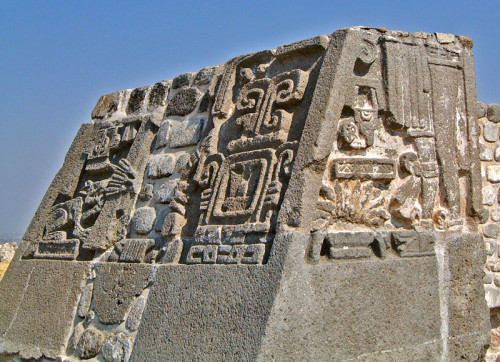
W0078: Relief on the Upper Front Left Wall and EntranceThe theme of warriorship is certainly present on the carvings found on the second tier of the structure, which was probably walled to a considerable height and roofed to create a temple enclosure. Evidence of this is found on the left-hand side of the entrance at the top of the stairs where there is a relief panel which features a pair of legs whose upper body would have featured on a missing upper section of the wall (see the close up in fig. W0078, which is also visible in context on the left at the top of the stairs on in fig W0095). This character wears slippers that are decorated with pompoms and has a garter tied below his right knee, which is reminiscent of the ritual ball-game attire that Mayan royalty are often depicted wearing. In front of his feet there appears to be a pot containing a maguey plant from which the intoxicating religious drink of pulque was made, which is a common sight on the relief panels of El Tajin. The front panel of this section features a date glyph on the right side and a coyote on the left side, who sits on a mat that is thought to be indicative of royalty. The central part of the panel is missing, although the remains of three feathered spear ends near the coyote’s mouth indicates that the central motif was the same as that found to the right of the temple entrance.
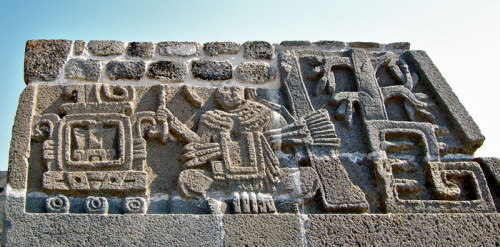
W0077: Relief on the Upper Front Right WallOn the right hand wall at the top of the stairs, the panel clearly shows a seated warrior-ruler, who wears an regal beaded necklace, holds aloft a staff of rulership, and carries a bundle of three spears with a rectangular shield. He faces a date glyph, which is principally the same as that on the left side but with a different number (the three dots at the bottom are single digits and the bar above denotes five, making the number 8, whereas the left-hand glyph appears to have two bars, which equals 10). Behind this right hand figure is a tree that appears to rise from a crocodilian symbol – the image looks like a crocodile sitting upright facing the warrior-lord, with his tail curling in from the bottom right. Other similar panels include symbols of eagles and jaguars, which has led to the hypothesis that these upper relief panels depict the warrior-lords of Xochicalco and its subordinate towns and villages, who are each distinguished by the various animal forms. This leads to a fractured message, with the bottom half seemingly describing a gathering of dignitaries to record a celestial event and the upper half describing the warriors and chiefs.
Further intrigue is added through the architectural style that was used for the Pyramid of the Plumed Serpents. The pyramidal base is built in the distinctive “Talud-Tablero” style, which is utilises two repeating elements: the “talud”, which is an inward sloping wall; and the tablero, a rectangular tier that protrudes like a table-top (see fig. W0095 & W0061P2D). Adapted styles are found across Mesoamerica and at Xochicalco they added an angled cornice to the tablero section to create their own unique style. Curiously, the Pyramid of the Plumed Serpent is the only construction at Xochicalco that uses this refined style – curiously, Buildings C and D are virtually identical in every way, apart from missing the unique tablero. Many other Mesoamerican cities feature just a single “talud-tablero” structure, which suggests the architectural style itself bears a specific meaning. The only exception is the great city of Teotihuacan, where the style was used prolifically, and this has led to the wide-spread belief that the Teotihuacano were responsible for spreading the style. The Teotihaucano are credited with creating a trade route that spanned the entire Mesoamerican subcontinent, which brought about the rapid growth of cities during the Classic Period (200AD-900AD). They are even thought to have conquered or influenced several other cities, including the Mayan cities of Tikal, Copan and Altun Ha – cities that each have a talud-tablero structure dating to somewhere between 300AD and 500AD which coincides with a Teotihuacano presence or influence in other art and pottery finds.
With so many influences contained within its symbolism, date glyphs, number system and architecture, the Pyramid of the Plumed Serpent is something of an enigma, which can be studied, researched, and theorised upon, but still not understood. The most likely purpose of the building appears to be either: a political statement and historical record, with Xochicalco’s conquests listed around the tablero section, along with the dates and tributes paid, with their warrior-chiefs listed on the upper tier with animals to distinguish their regiment or district, and dates to record their subjugation, alliance, victory or defeat; or, it was built to host and record the witnessing of a celestial event, with the attendees pictured around the tablero section and the great rulers of Mesoamerica listed around the upper tier, with animals used to distinguish their regional authority and dates to list their age, accession or alliance with Xochicalco.
Considering the feathered serpents are the most outstanding feature on the walls, it is logical that they bear the most significance – which brings us to another theory. Interestingly, there was a Lord named Quetzalcoatl (his full name was Topiltzin Cē Ācatl Quetzalcōatl) who ruled as a demi-god in a city known as Tollan, thought to be Tula or Teotihuacan. He is thought to have been exiled in the 9th century and headed east, settling eventually at the Mayan city of Chichen Itza. The Mayan and Teotihuacano influences that can be seen in the Pyramid of the Plumed Serpent, has led to a theory that Topiltzin Ce Acatl Quetzalcoatl either came here and reigned following his departure from Tollan or was from a royal lineage that was formed here and then went to Tollan to rule – possibly as the result of a conquest. This theory suggests that the Pyramid of the Plumed Serpent was built to commemorate this royal feathered-serpent lineage and that the remainder of the carvings are indeed the political achievements, conquests, subjugates, lords and leaders belonging to this feathered-serpent family. However, an alternative theory suggests that Topiltzin Cè Ãcatl Quetzalcõatl was studied at Xochicalco and learnt the ways of the feathered-serpent from the priests here, before heading west to rule at Tollan at which point he changed his named to reflect his affinity with the god, Quetzalcoatl. This theory suggests that the figures entwined within the snakes could be the high-priests of this special religious order and therefore the Pyramid of the Plumed Serpent could be a record of a religious ceremony organised to celebrate a celestial event, including the people that were involved.

